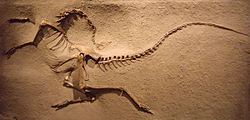Kingdom Animalia Clade Dinosauria Suborder Theropoda Scientific name Maniraptoriformes | Phylum Chordata Order Saurischia Clade Tyrannoraptora Higher classification Tyrannoraptora | |
 | ||
Lower classifications Maniraptora, Bird, Avialae, Microraptor, Therizinosaurus | ||
Maniraptoriformes is a clade of dinosaurs with pennaceous feathers and wings that contains ornithomimosaurs and maniraptors. This group was named by Thomas Holtz, who defined it as "the most recent common ancestor of Ornithomimus and birds, and all descendants of that common ancestor."
Contents
Fossil evidenceEdit
Many fossils have been discovered in recent years, particularly in China. Many of the feathered dinosaurs belong to this clade. In particular, a fossil of the Alvarezsauridae Shuvuuia has a version of keratin consistent with that of avian feathers.
Many nearly complete fossil maniraptoriforms are known from the late Jurassic. Archaeopteryx is known from Bavaria at 155-150 Ma. Ornitholestes, the troodontid WDC DML 001, Coelurus fragilis and Tanycolagreus topwilsoni are all known from the Morrison Formation in Wyoming at about 150 Ma. The Daohugou biota, including Anchiornis and Epidexipteryx, is the earliest record of maniraptoriformes, dating to about 160 Ma. One possible maniraptoriform, Eshanosaurus, lived even earlier, during the Early Jurassic, though its identification is controversial.
The wide range of fossils in the early Cretaceous and morphological evidence suggests that the main branches of maniraptoriform differentiation were separate before the end of the Jurassic.
Until recently, the relatives of Tyrannosaurus were thought to be maniraptoriforms, but this now seems unlikely.
History of studyEdit
In 1994, a study by paleontologist Thomas Holtz found a close relationship between the Ornithomimosauria and Troodontidae, and named this group Bullatosauria. Holtz rejected this hypothesis in 1999, and most paleontologists now consider troodontids to be much more closely related to either birds or Dromaeosauridae than they are to ornithomimosaurs, causing the Bullatosauria to be abandoned. The name referred to the inflated (bulbous) sphenoid both groups shared. Holtz defined the group as the clade containing the most recent common ancestor of Troodon and Ornithomimus and all its descendants. The concept is now considered redundant, and the clade Bullatosauria is now viewed as synonymous with Maniraptoriformes. In 2002, Gregory S. Paul named an apomorphy-based clade Avepectora, defined to include all theropods with a bird-like arrangement of the pectoral bones, where the angled shoulder girdle (coracoids) come in contact with the breastbone (sternum). According to Paul, ornithomimosaurs are the most basal members of this group.
ClassificationEdit
The relationships among coelurosaurs shown below were found in a phylogenetic analysis by Godefroit and colleagues in 2013.
